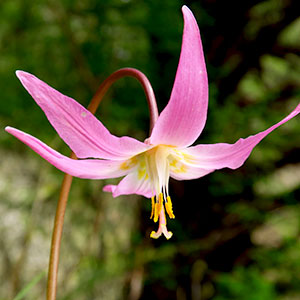Erythronium revolutum
Erythronium americanum
coast fawn lily, mahogany fawn lily, pink fawn-lily
American trout-lily, dogtooth violet, trout lily, yellow trout-lily, érythrone d'amérique
narrowly ovoid, 35–50 mm, sometimes producing sessile offsets.
ovoid, 15–28 mm;
stolons 1–3, common, mostly on 1-leaved, nonflowering plants.
10–25 mm;
blade distinctly mottled with irregular streaks of brown or white, broadly lanceolate to ovate, margins entire to ± wavy.
8–23 cm;
blade green, irregularly mottled, elliptic-lanceolate to ovate or elliptic, ± flat, glaucous, margins entire.
15–40 cm.
10–18 cm.
1–3-flowered.
1-flowered.
tepals uniformly clear violet-pink at anthesis, with yellow banding at base, lanceolate to narrowly elliptic, 25–40 mm, inner with small auricles at base;
stamens ± appressed to style, 12–22 mm;
filaments white to pink (darkening with age), flattened, ± lanceolate, 2–3 mm wide;
anthers bright yellow;
style white to pink, 12–18 mm;
stigma with slender recurved lobes 4–6 mm.
tepals yellow, sometimes tinged light to dark purple-red abaxially, sometimes with reddish dots adaxially, strongly reflexed at anthesis, lanceolate, 20–33 mm, inner with small auricles;
stamens 9–15 mm;
filaments yellow, lanceolate;
anthers yellow, chestnut brown, or lavender;
pollen yellow or brown;
style deciduous or base forming small apiculum, greenish yellow, 5–11 mm, swollen distally or ± terete;
stigma lobes erect or recurved, 1.5 mm.
oblong to obovoid, 3–6 cm.
held erect or at least off ground at maturity, obovoid, 12–15 mm, apex rounded, truncate, or apiculate.
= 48.
Erythronium revolutum
Erythronium americanum
Varieties 2 (2 in the flora).
Erythronium americanum is a very common and widespread species, particularly in northeastern North America, becoming less frequent towards the southern and western limits of its range. Nonflowering plants far outnumber flowering ones in most populations because of their extensive stolon production. Plants with brown anthers have been called forma castaneum L. B. Smith.
(Discussion copyrighted by Flora of North America; reprinted with permission.)
1. Capsule apex rounded, truncate, or short-apiculate; stigma lobes erect, not grooved; widespread in ne United States | subsp. americanum |
1. Capsule apex distinctly apiculate; stigma lobes recurved, grooved distally; n Alabama, Georgia, ne Mississippi, Tennessee | subsp. harperi |
- Local floras:
BC,
CA,
OR,
WA
- Local Web sites:
CalFlora,
CalPhotos,
Flora NW,
PNW Herbaria,
Turner Photog.
WildflowerSearch
iNaturalist (observations)
USDA Plants Database
- LBJ Wildflower Center
- SEINet
- Plants of the World Online
- Encyclopedia of Life
- Wikipedia
- Google Image Search


